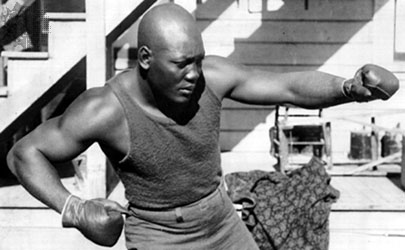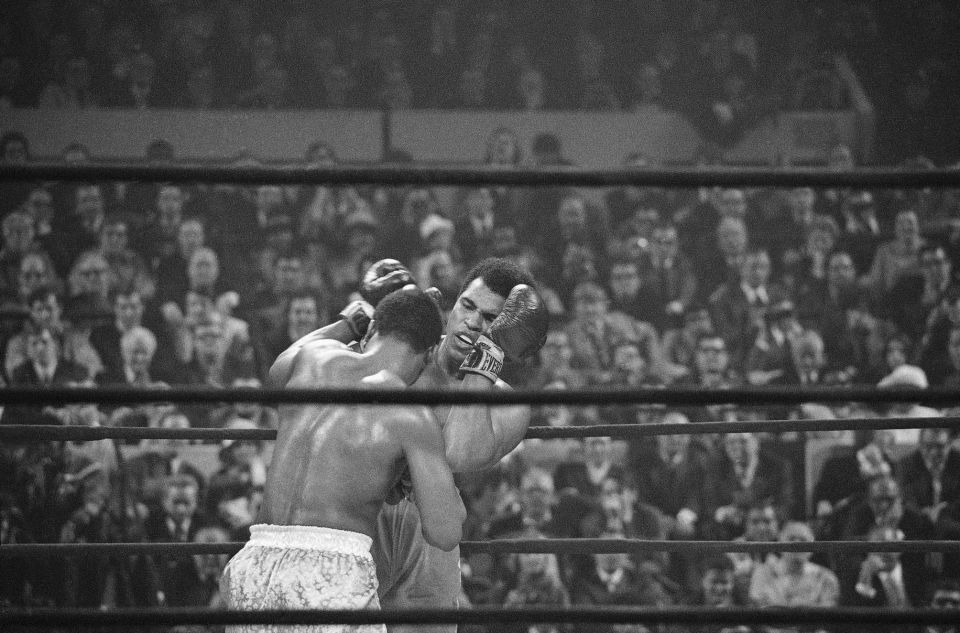

Jack Johnson, 78-11-14-2 NC*, was and is considered by many historians and sports writers as one of the greatest heavyweight boxers of all time. There is no questioning Johnson’s historical significance as the first black world heavyweight boxing champion. The fact that he was able to ascend to the heavyweight throne against significant racism and retire from the ring virtually unmarked speaks volumes about his ability. Like Muhammad Ali he had great natural physical gifts, speed, reflexes, anticipation/judgment of distance and strength. He used these abilities as a renowned defensive boxer who could block and counter with a reputation rivaling that of Floyd Mayweather Jr. in our time. The question here is would Johnson’s skill set hold up in a modern ring against a more sophisticated attack? To answer that question we need to take a look at Jack Johnson the boxing stylist.
Nat Fleischer, founder of The Ring magazine, wrote in 1958 that Johnson’s “mastery of ring science, his ability to block, counter, and feint, are still unexcelled” in his book 50 Years at Ringside. Johnson was primarily a counter-puncher much like Roy Jones Jr. He was lightning-quick in his ability to leap in and score with surprising counter strikes. Like Roy he did not like to lead but preferred to let his opponent bring the fight to him. Johnson rarely threw a lead jab, but instead would slide straight back, glove block his opponent’s leads and then counter. Another thing Jack Johnson has in common with Roy Jones is his ability to fight inside or off the ropes. Jones would fire rapid flurries off the ropes, go to the body and counter. Johnson’s approach was a little different, he would stymie an opponent by holding, shoving their shoulders like George Foreman did against Joe Frazier and would arm lock them in place like Mike Tyson did against Francois Botha, and then use sizzling uppercuts inside while grappling with his opponents. Rarely did Johnson throw combinations but would counter with one or two punches and then slide back so as to lure his opponent to rush at him, like Tommy Burns did time and again, and then pick off their wide lead hooks and jabs negating their primitive rushes and then counter again with one or two punches. This Jack Johnson did better than any heavyweight of his era.
Jack Johnson, often called the “Galveston Giant,” was certainly bigger than most of his opposition which is why he was able to get away with things like the shoulder shove against a shorter fighter; the fact that Johnson was physically bigger and stronger than most of his opposition contributed to his success. The crowding style fighters of Johnson’s day lacked boxing refinement with their face first, straight line linear attacks. They more closely resembled a nose tackle in American football jockeying for position at the line of scrimmage rather than the finesse of side to side movement that we see arriving with Jack Dempsey and later with Joe Frazier and Mike Tyson. Men like Tommy Burns, Fireman Jim Flynn and Frank Moran were cloddish in their aggression, completely lacking cunning and sophistication. Johnson looked like a defensive genius neutralizing their boorish aggression. The swarmers of this era were totally clueless on how to pressure a boxer like Johnson. They simply did not know how to attack, cut the ring or put on effective pressure. They would be just as lost trying to fight against men like Ezzard Charles, Jersey Joe Walcott, Muhammad Ali or even former WBA Champion Jimmy Ellis. Not only Ellis but modern boxers such as Greg Page or even Pinklon Thomas would be just as dominant as Johnson was against such, raw, crude opposition.
Let’s be honest, the heavyweights of this era look questionable on the films we have. One of the best available films is that of the Sam McVea-Battling Jim Johnson bout from 1910. Both McVea and Jim Johnson look completely crude showing no head movement, no side to side movement, little footwork with their heads often straight up rather than chins down, and moving straight back into the line of fire. The film reveals heads up linear attacks, some feinting but also wide open winging punches. Nothing that compares to the tight defense, head slips, and side to side weaving combined with countering that a modern swarmer like Mike Tyson implements. I am reminded of Jimmy Jacobs argument with Nat Fleischer from the Great Debate in the March 1968 Ring. In that article Jacobs relayed how he had shown some films with speed correction to a group of old-timers—without saying who the participants were—the old-timers would shout, “who are these bums” and when told the films were the likes of Jim Corbett, Bob Fitzsimmons, Jim Jeffries. George Dixon and Abe Attell they were silenced.
On the other hand the more recently found Sam Langford-Joe Jeannette film of the same period looks better. Jeannette had an educated jab and better movement while Sam looks indestructible with his power and aggression but even here Jeannette hardly resembles Ezzard Charles in his boxing acumen, nor does the powerful Langford look as sophisticated as the bobbing and weaving Joe Frazier in his attack, relying more on his strength, brutal power and toughness to take it to his opponents. It is noteworthy that Jack Johnson avoided the dangerous Langford once Sam reached the peak of his career.
Notice that Sam McVea was only 18 years old when he first fought Jack Johnson. Their first fight was McVea's 7th pro fight whereas Johnson was already a seasoned veteran. In their third and final fight McVea was only in his 11th pro fight and he had just turned 20 years old 10 days previous. Joe Jeannette is a similar story. Jeannette faced Johnson for the first time in Joe's 4th pro fight whereas Johnson already had over 30 pro fights. At the time of their final meeting Jeanette had only 17 pro fights with a record of 9-7-1. As for Sam Langford he only weighed 156 pounds during their only fight. Its like giving credit to Larry Holmes for decisioning a 160 pound Marvin Hagler. Once these men became experienced legitimate contenders to the crown, Johnson avoided them at all costs. While Jack Johnson is given props for being the first black heavyweight champion it should also be made clear that he too drew the color line not giving Langford, Jeannette or McVea title shots once he was champion.
Mike Tyson spoke of the stylistic problems Jack Johnson would face in a modern ring. In the BBC video Tyson and the Heavyweights, 1988, with British boxing historian Harry Carpenter (this is available on YouTube) Mike explains that the things Jack Johnson did would be so much more difficult to do today because Johnson would block “a punch at a time” and today fighters “throw seven or eight punches, consistent punches.” Johnson could not just slide back and pick off punches out of the air against a fighter like Joe Louis or Evander Holyfield due to their multi-punch combinations. Nor would he be able to nullify a swarmer with a more complex and seasoned attack like that of Frazier or Tyson. Neither Frazier nor Tyson pursued in a straight line like the men that Johnson fought but instead gave angles and side to side upper body movement. Instead of coming straight forward as a perfect target for Johnson’s punches, they slipped to the side and attacked body to head and in combinations. Both of these men would be able to do what the crowding style fighters of his day could not and that is to take away Johnson’s space and force him to rush his punches. Frazier was able to force the greatest escape artist in history, Muhammad Ali, to stand his ground and fight him off. If Johnson tried to hold, Frazier would dig both hands to the body, if he tried to slide back and counter Frazier—and Tyson too—would bob and weave forcing him to miss and come around or up the middle with hammering counters of their own. Johnson would be forced to fight against fighters that were as big and physically strong as he was and who were much harder punchers.
One well known writer stated incorrectly that Joe Frazier didn't cut the ring on Muhammad Ali because he didn't step first to cut off Ali in their fights. This is plain dumb. A boxer has to move first in order to know which way to step to cut them off. Frazier cut off Ali better than any boxer-mover has ever been cut off. If a swarmer steps to cut off a boxer before he knows which way he is going to move then he is 2 steps behind. The fact that the writer didn't understand this puts his reputation for advocating for the "old-timers" in jeopardy. Truth is the pressure fighters of Johnson's era where straight in linear attackers who did not know how to cut the ring, had no side to side to side pressure, no slipping and countering. How can some boxing writers and fans not see this when they watch tapes? Do they know what they are seeing? The above mentioned writer obviously does not.

Johnson had very weak opposition who were either green when he faced them or were just not very good to begin with. Faced with modern day all time greats the "Galveston Giant" would be facing men as big or bigger than himself who would test the quality of his chin. Johnson was once knocked out by 168-pound Joe Choynski. Can one imagine a 168- or even 175-pound Roy Jones knocking out 21-year-old Mike Tyson? Forget that there was an agreement for Johnson to carry middleweight champion Stanley Ketchel, a middleweight’s punch put him on the canvas. Could Marvin Hagler have put Joe Frazier or Mike Tyson on the canvas? For those who live in a fantasy world please recall that Hagler never fought even a light heavyweight and realize that Frazier destroyed hard-hitting 175-pound Bob Foster in two rounds. If a 160-pound boxer’s punch could put Johnson on the canvas then what would Joe Frazier’s left hook or Mike Tyson’s barrage of punches do to him? What would happen in a Roy Jones versus Mike Tyson showdown? Jack Johnson’s chin is really no better than that of Roy Jones. Both men were able to avoid blows due to their superiority over their opposition but when caught folded like an accordion.
Jack Johnson is a fighter who is looked at through a pair of rose-colored glasses. He is viewed through the eyes of nostalgia and historical significance and not by how he and his contemporaries appear on film. It may not be popular to criticize him because of his place at the forefront of black champions but Jack Johnson—if he were teleported from his championship days to a modern ring—would not do well against many of the more contemporary greats.
*Record is from Herb Goldman’s Boxing Record Book Vol 2, page 614 includes Newspaper decisions.
Jack Johnson Was Not as Great as You Were Told! Video